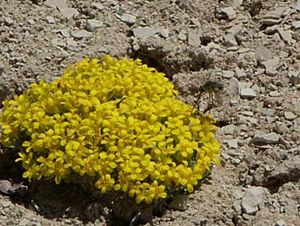Kodachrome bladderpod facts for kids
Quick facts for kids Kodachrome bladderpod |
|
|---|---|
 |
|
| Conservation status | |
| Scientific classification | |
| Genus: |
Physaria
|
| Species: |
tumulosa
|
| Synonyms | |
|
Lesquerella tumulosa |
|
The Kodachrome bladderpod (Physaria tumulosa) is a very rare flowering plant. It belongs to the Brassicaceae family, which includes plants like mustard. This special plant grows only in Utah, United States. Specifically, you can find it in Kane County.
There is only one main group of these plants known. It lives entirely within the Kodachrome Basin. This group has about 20,000 individual plants spread out. The Kodachrome bladderpod is in danger because its home is being damaged. The United States government lists it as an endangered species.
About the Kodachrome Bladderpod
The Kodachrome bladderpod is a perennial herb. This means it is a plant that lives for more than two years. It does not have a woody stem. It grows short stems from a hidden caudex, which is a tough, woody base underground. The plant forms a low, dense mat only a few centimeters tall.
What It Looks Like
The plant's mat has leaves that are a bit hairy and somewhat fleshy. They are shaped like lines or spear tips and can be up to 1.2 centimeters long. Its flowers grow in a tight cluster called a raceme. These flowers are bright yellow. After the flowers, the plant produces a fruit. This fruit is an inflated silique, which is a type of pod. It is only a few millimeters wide.
Where It Lives
The only known group of Kodachrome bladderpod plants lives mostly in two special areas. These are the Grand Staircase–Escalante National Monument and Kodachrome Basin State Park. It prefers to grow on dry, white shale rocks. These rocks are part of the Carmel Formation, a specific type of rock layer.
This plant grows at an elevation of about 1,740 meters (5,700 feet). It often grows near other plants like buckbrush (Purshia tridentata) and yellow cryptantha (Cryptantha flava). However, it mostly grows on bare, rocky ground where not many other plants can survive.
Facing Challenges
The Kodachrome bladderpod is a "narrow endemic." This means it grows in a very small, specific area. The land where it lives is affected by several problems. The biggest threat to this plant is the use of off-road vehicles.
These vehicles can harm the plant in several ways. They cause soil degradation, which means the soil gets damaged. They also lead to erosion, where the soil is washed or blown away. Sadly, vehicles can also directly kill the plants. In the past, gravel mining was also a threat. However, since the area became a national monument, these mining activities have stopped.


